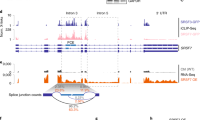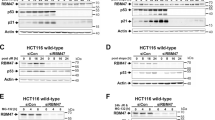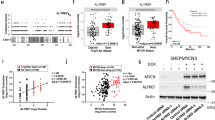Abstract
The ASPP1 (Apoptosis Stimulating Protein of p53) protein is an important tumour-suppressor. We have detected a novel protein interaction between the human ASPP1 (hASPP1) protein and the predominantly nuclear adaptor protein SAM68. In the human testis, full-length endogenous hASPP1 protein is located in the nucleus like SAM68, predominantly within meiotic and postmeiotic cells. Mouse ASPP1 (mASPP1) protein is mainly expressed in the brain and testis. The interaction with nuclear SAM68 is likely to be restricted to human germ cells, since endogenous mASPP1 protein is exclusively cytoplasmic. The C-terminal region of hASPP1 efficiently targeted a fused GFP molecule to the nucleus, whereas the N-terminus of hASPP1 targeted GFP to the cytoplasm. In the context of the full-length molecule this cytoplasmic targeting sequence is dominant in HEK293 and Saos-2 cells, since full-length hASPP1-GFP is almost exclusively cytoplasmic. Despite its predominantly cytoplasmic location, we show that ASPP1-GFP expression in HEK293 cells can regulate the ratio of alternative spliced isoforms derived from a pre-mRNA regulated downstream of cytoplasmic signalling pathways, and our data suggest that ASPP1 may operate in this case downstream or parallel to RAS signalling pathways.
This is a preview of subscription content, access via your institution
Access options
Subscribe to this journal
Receive 50 print issues and online access
$259.00 per year
only $5.18 per issue
Buy this article
- Purchase on Springer Link
- Instant access to full article PDF
Prices may be subject to local taxes which are calculated during checkout






Similar content being viewed by others
References
Bergamaschi D, Samuels Y, O'Neil NJ, Trigiante G, Crook T, Hsieh JK et al. (2003). Nat Genet 33: 162–167.
Bjorge JD, Jakymiw A, Fujita DJ . (2000). Oncogene 19: 5620–5635.
Chen T, Damaj BB, Herrera C, Lasko P, Richard S . (1997). Mol Cell Biol 17: 5707–5718.
Coutts AS, La Thangue NB . (2005). Biochem Biophys Res Commun 331: 778–785.
Di Fruscio M, Chen T, Bonyadi S, Lasko P, Richard S . (1998). J Biol Chem 273: 30122–30130.
Elliott DJ, Bourgeois CF, Klink A, Stevenin J, Cooke HJ . (2000a). Proc Natl Acad Sci USA 97: 5717–5722.
Elliott DJ, Venables JP, Newton CS, Lawson D, Boyle S, Eperon IC et al. (2000b). Hum Mol Genet 9: 2117–2124.
Forch P, Puig O, Kedersha N, Martinez C, Granneman S, Seraphin B et al. (2000). Mol Cell 6: 1089–1098.
Grossman JS, Meyer MI, Wang YC, Mulligan GJ, Kobayashi R, Helfman DM . (1998). Rna 4: 613–625.
Harlow E, Lane D . (1999). Using Antibodies. A Laboratory Manual. Cold Spring Harbor Press.
Hartmann AM, Nayler O, Schwaiger FW, Obermeier A, Stamm S . (1999). Mol Biol Cell 10: 3909–3926.
Hong W, Resnick RJ, Rakowski C, Shalloway D, Taylor SJ, Blobel GA . (2002). Mol Cancer Res 1: 48–55.
Liu ZJ, Lu X, Zhang Y, Zhong S, Gu SZ, Zhang XB et al. (2005). FEBS Lett 579: 1587–1590.
Liu ZJ, Zhang Y, Zhang XB, Yang X . (2004). Leukemia 18: 880.
Lukong KE, Richard S . (2003). Biochim Biophys Acta 1653: 73–86.
Maniatis T, Reed R . (2002). Nature 416: 499–506.
Matter N, Herrlich P, Konig H . (2002). Nature 420: 691–695.
Naumovski L, Cleary ML . (1996). Mol Cell Biol 16: 3884–3892.
Paronetto MP, Venables JP, Elliott DJ, Geremia R, Rossi P, Sette C . (2003). Oncogene 22: 8707–8715.
Pillay I, Nakano H, Sharma SV . (1996). Cell Growth Differ 7: 1487–1499.
Reddy TR, Suhasini M, Xu W, Yeh LY, Yang JP, Wu J et al. (2002). J Biol Chem 277: 5778–5784.
Rodriguez-Viciana P, Warne PH, Dhand R, Vanhaesebroeck B, Gout I, Fry MJ et al. (1994). Nature 370: 527–532.
Samuels-Lev Y, O'Connor DJ, Bergamaschi D, Trigiante G, Hsieh JK, Zhong S et al. (2001). Mol Cell 8: 781–794.
Sjoblom T, Lahdetie J . (1996). Oncogene 12: 2499–2505.
Slee EA, Gillotin S, Bergamaschi D, Royer C, Llanos S, Ali S et al. (2004). Oncogene 23: 9007–9016.
Slee EA, Lu X . (2003). Toxicol Lett 139: 81–87.
Smith CW, Valcarcel J . (2000). Trends Biochem Sci 25: 381–388.
Stamm S . (2002). Hum Mol Genet 11: 2409–2416.
Takahashi N, Kobayashi S, Jiang X, Kitagori K, Imai K, Hibi Y et al. (2004). Biochem Biophys Res Commun 315: 434–438.
Taylor SJ, Resnick RJ, Shalloway D . (2004). BMC Cell Biol 5: 5.
Venables JP, Dalgliesh C, Paronetto MP, Skitt L, Thornton JK, Saunders PT et al. (2004). Hum Mol Genet 13: 1525–1534.
Venables JP, Vernet C, Chew SL, Elliott DJ, Cowmeadow RB, Wu J et al. (1999). Hum Mol Genet 8: 959–969.
Vernet C, Artzt K . (1997). Trends Genet 13: 479–484.
Vogelstein B, Lane D, Levine AJ . (2000). Nature 408: 307–310.
Wyckoff GJ, Wang W, Wu CI . (2000). Nature 403: 304–309.
Yang JP, Hori M, Takahashi N, Kawabe T, Kato H, Okamoto T . (1999). Oncogene 18: 5177–5186.
Yang JP, Reddy TR, Truong KT, Suhasini M, Wong-Staal F . (2002). Oncogene 21: 7187–7194.
Zhang X, Wang M, Zhou C, Chen S, Wang J . (2005). Leuk Res 29: 179–183.
Acknowledgements
We thank Dr Rachel Davies, Dr Mauro Santibanez Koref, Dr Sushman Nagaraj-Grellscheid and Dr Alison Trainer for their comments, Professor Julian Downward for the dominant-negative RAS construct, Professor Stefan Stamm for the CD44 minigene and Derek Hawes for help with photography. Jared Thornton was supported by a Luccock PhD studentship (University of Newcastle). Kate Sergeant is a William Ross CRUK student. This work was supported by the BBSRC, the Special Trustees of the RVI and Wellcome Trust by Project Grants to DJE.
Author information
Authors and Affiliations
Corresponding author
Rights and permissions
About this article
Cite this article
Thornton, J., Dalgleish, C., Venables, J. et al. The tumour-suppressor protein ASPP1 is nuclear in human germ cells and can modulate ratios of CD44 exon V5 spliced isoforms in vivo. Oncogene 25, 3104–3112 (2006). https://doi.org/10.1038/sj.onc.1209341
Received:
Revised:
Accepted:
Published:
Issue Date:
DOI: https://doi.org/10.1038/sj.onc.1209341
Keywords
This article is cited by
-
EGR-1/ASPP1 inter-regulatory loop promotes apoptosis by inhibiting cyto-protective autophagy
Cell Death & Disease (2017)
-
The RNA-binding protein Sam68 regulates expression and transcription function of the androgen receptor splice variant AR-V7
Scientific Reports (2015)
-
Downregulation of ASPP1 in gestational trophoblastic disease: correlation with hypermethylation, apoptotic activity and clinical outcome
Modern Pathology (2011)
-
ASPP: a new family of oncogenes and tumour suppressor genes
British Journal of Cancer (2007)



